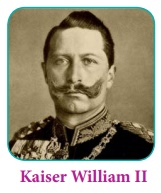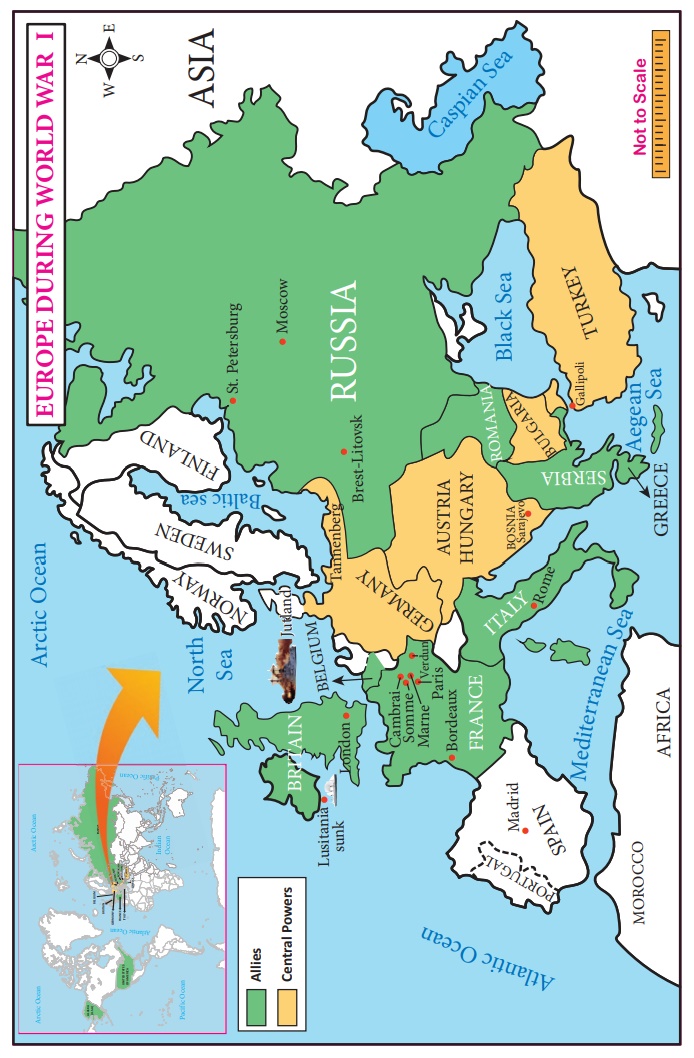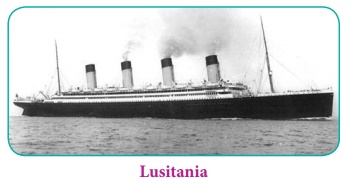Imperialism and its Onslaught | History - World War I | 12th History : Chapter 13 : Imperialism and its Onslaught
Chapter: 12th History : Chapter 13 : Imperialism and its Onslaught
World War I
World War I
(a) Pre-War Power Politics Europe
By the
turn of the century Germany had emerged as the most powerful industrial state
in the Continent. By then the world was largely occupied by the other
imperialist powers. Under Kaiser William
II, Germany sought colonies. Its ambition was to gain control over north
Africa. German capitalists and imperialists also desired eastward expansion and
the government obliged them by constructing a railway line from Berlin to Baghdad
to facilitate economic control of the Ottoman Empire.

The objective of France was to recover Alsace and
Lorraine that it had lost after the Franco-Prussian War (1871). The French also
had an ambition of adding mineral-rich Morocco to their African empire. Russia
entertained the hope of gaining control of the Bosporus and the Dardenelles
(under Turkey’s control then), as they were expected to give access to the Mediterranean
and to take possession of Istanbul. Russia’s plan was to lay claim to the
Balkans once Turkey was eliminated from Europe. Italian foreign policy was
based on hopes at the expense of Austria and Turkey. Austria’s hold on Trieste
and other parts of Adriatic coast was precarious since much of this territory
was inhabited by Italians. Turkey blocked Italy’s acquisition of Tripoli and
other territories in North Africa. As for Britain, despite the lead in
industrial growth and control of a vast empire, it had to compete with Germany
and the United States, which were producing cheaper manufactured goods and thus
capturing England’s markets.

Asia
In Asia, during the Meiji era (1867–1912), as Japan
became a great industrial power and the Japanese people more educated, there
developed an aggressive nationalism and a wish to become a world power. Japan
joined in the scramble for China. Japan invaded Korea, then an independent
kingdom and drove out the Chinese army. In the ensuing Sino-Japanese War,
according to the Treaty of Shimonoseki signed at the end, Japan got Formosa,
Port Arthur and Liaotung peninsula. The crushing defeat of China by Japan in
(1894–95) surprised the world. Fearing this sudden increase in Japan’s power,
the European powers forced Japan to give up the Liaotung peninsula. Japan
resented this “Triple Intervention” (intervention of France, England and Russia
in 1895) and embarked on a big armaments programme.
Japan in “Charmed Circle of Great Powers”
Even more significant than the Sino– Japanese War
was the Japanese defeat of Russia in 1904–05. Following the “Triple
Intervention,” Russia had occupied southern Manchuria. Japan entered into an
alliance with England in 1902 and demanded that Russia withdraw its troops.
Russia underestimated Japan. In 1904 a war broke out. In this Russo-Japanese
War, Japan was victorious and by the treaty of Portsmouth signed at the
mediation of the USA, Japan got back Port Arthur. With this war Japan had
entered the “charmed circle of the great Powers”.
Strong-arm Diplomacy of Japan after 1905
The assassination of a prominent Japanese diplomat by a Korean provided the excuse in 1910 for Japan’s annexation of Korea. The confusion in China following the downfall of Manchu dynasty in 1912 provided Japan with an opportunity for further expansion. In 1915 Japan presented Twenty-One Demands to the President of the newly established Chinese Republic, Yuan Shih-kai. These demands included transfer of German rights in the Chinese coastal province of Shantung to Japan and the recognition of Japanese hold over Manchuria, and the appointment of Japanese advisers to the Chinese government. The Chinese had to concede most of the Japanese demands.
(b) Causes of the War
(i) The Evolution of the System of Alliances
The evolution of the system of alliances goes back
to the 1870s. Its original architect was Bismarck. Bismarck feared that the
French, on losing Alsace and Lorraine, might launch a war of revenge. Therefore
he was determined to isolate France. His Three Emperors League (1873), an
alliance involving Germany, Austria and Russia, however failed. But he
succeeded in cementing a strong relationship with Austria, which,
expectingtroubles from the Slavs inside and outside its borders, wanted to have
an understanding with Germany. In 1882 this alliance was expanded into the
Triple Alliance with the inclusion of Italy.

As a counter-move to Germany, France started
negotiations with Russia which ended in a secret military pact signed in 1894.
Accordingly, it was decided that each should come to the aid of the other in
case of an attack by Germany, or Austria or Italy supported by Germany. In the
meantime, Britain abandoned its isolation and struck an alliance with Japan.
Since France was Russia’s ally, Japan preferred to ally with Britain (1902).
The Anglo–Japanese Alliance prompted France to seek an alliance with Britain to
resolve disputes over Morocco and Egypt. This resulted in the Entente Cordiale
(1904). In return for letting the French have a free hand in Morocco, France
agreed to recognize the British occupation of Egypt. Britain subsequently
reached an agreement with Russia in 1907 for the division of Persia into
spheres of influence. Thus was formed the Triple Entente of Britain, France and
Russia
Thus, by 1907, the great powers of Europe had come
to be arrayed in two opposing camps: the Triple Alliance (Germany,
Austria-Hungary and Italy) and the Triple Entente (Britain, France and Russia).
(ii) International Crises between 1905 and 1913
Morocco
Relying on their understanding with England
(Entente Cordiale, 1904) the French decided to go ahead with their plan in
Morocco. Early in 1905, a French mission arrived at Fez, a city in Morocco,
treating it as a part of French protectorate. Germany protested. French agreed
to refer the dispute to a European conference. Nothing came of this conference
held at Algiers. Yet it was clear that Britain had ranged itself on the side of
France against Germany.
Agadir, 1911
Within a year, the French were again active in
Morocco. This time the Germans sent their gunboat Panther to Agadir, a sea port on the Moroccan coast claiming German
interests there. The Germans took notice of British threats and decided not to
precipitate the matter further. However, France had to make considerable
concessions to Germany in West Africa to balance the French gains in Morocco.
Bosnian Crisis
A serious crisis occurred in 1908 when
Austria–Hungary suddenly announced the annexation of Bosnia (peopled by
Serbians) and Herzegovina, which until then had remained an Austrian
protectorate. This was a strategic move on the part of Russia that gave freedom
to move its warships, through the Dardanelles and the Bosporus, to the
Mediterranean. The Turks were angry but could do nothing. Serbia was furious
and appealed to Russia for help. But Russia had not fully recovered from the
war with Japan and did not therefore intervene, as it would have to face an
aggressive Germany in support of Austria-Hungary. So Russia and Serbia had to
wait until a more favourable time.
The Balkan Wars
Turkey was a powerful country in the south-west of
Europe in the first half of eighteenth century. Its empire extended over the
Balkans and across Hungary to Poland. (Balkans is a region in south-eastern
Europe between the Mediterranean and the Black Sea.) Taking advantage of the
political and economic instability of the Turkish Empire from the second half
of the eighteenth century, Greece, followed by others, began to secede, one
after another, from Turkish control.
Balkan War I
With encouragement from Russia, Greece, Serbia,
Bulgaria and later Montenegro the Balkan League was formed in March 1912 to
take over Macedonia. Macedonia had a mixed population.The war started in
October 1912 and in less than two months the resistance of the Turks was
broken. The Turks were driven from their European provinces. But the problem
started while dividing the conquered territories. According to the Treaty of
London signed in May 1913 the new state of Albania was created and Macedonia
was divided.
Balkan War II
The victors quarrelled over the division of
Macedonia. Bulgarians attacked their allies Serbia and Greece, but were easily
defeated. The Turks took the opportunity to retake Adrianople, which they had
lost. The second Balkan War ended with the signing of the Treaty of Bucharest
in August 1913.
Two things emerged out of the Balkan crisis. First,
the Bulgarians felt injured and awaited an opportunity to take revenge on
Serbia. Secondly, the passions of the Serbians were inflamed by victory. From
this time on, anti-Austrian struggle in Serbia and in the neighbouring province
of Bosnia became ever more militant.
Immediate Cause
The climax to these events in the Balkans occurred
in Sarajevo in Bosnia. On 28 June 1914 the Archduke Franz Ferdinand, heir to
Franz Joseph, Emperor of Austria-Hungary, was assassinated by a Bosnian student
Princip, a Serb. Austria asserted that the assassin had acted at the
instigation of Serbia. After a month, an ultimatum was served to Belgrade,
demanding unconditional surrender. The Serbian explanation and Germany’s effort
at mediation were turned down by Austria. Britain tried to localise the war. On
28 July Austria declared war on Serbia and bombarded Belgrade. Even as Russia
was mobilising forces to intervene in support of Serbia, Germany struck first.
It declared war on Russia and its ally France on 1 August.

Britain was against involving itself in the War.
But on 3 August, an appeal came from the King of Belgium asking for British
help. Belgium was not on the side of the Allies. Yet it was invaded by Germany.
The German violation of Belgian neutrality was viewed seriously. It had been
the age-long policy of Britain that the Belgian coast should not be in the
hands of any adjacent Great Powers, which might use those shores as a basis for
invasion. So in pursuance of this principle of national security Britain now
decided to fight Germany. On 3 August an ultimatum was served on Germany
demanding its immediate withdrawal from Belgian soil. On 4 August Britain and
Germany were at war.

(c) Course of the War War Spreads
Following Britain’s plunge into the war other
nations were quickly drawn into the conflict. Montenegro joined with the Serbia
on 7 August in fighting Austria. Two weeks later the Japanese declared war on
Germany, with the intention of conquering German possessions in the Far East.
In October Turkey began the bombardment of Russian ports in the Black Sea.
Italy maintained neutrality until May 1915, but was dragged into the war on the
side of Triple Entente powers, with the promise of Austrian and Turkish
territories.
Central Powers and Allies
The warring nations were grouped into two, namely
the Central Powers and the Axis. The Central Powers consisted of Germany,
Austria–Hungary, Turkey and Bulgaria. The nine states that opposed the Central
powers were: Russia, France, Britain, Italy, the United States, Belgium,
Serbia, Romania and Greece. Most Americans wanted their country to remain
neutral and therefore in the first three years the United States gave only
moral support and (valuable) material aid to Britain and France.
Battle of the Frontiers Western Front, 1914
Belgians could do little in the face of German
invasion except to make a formal protest against the violation of their
neutrality. So the burden of breaking the advancing German army fell on the
French. The French could not stop the overwhelming force of invasion. The first
German advance was within twenty miles of Paris. The panicked French government
had to move to Bordeaux.
Eastern Front, 1914
On the Eastern Front, the Russian forces penetrated
far into East Prussia, In the battle of Tannenberg Russia suffered heavy losses
on account of the decisive role played by Von Hindenburg. The German general
Hindenburg later began the invasion of Russian Poland. But trapped in a
two-front war, Germany never had sufficient resources to consolidate its
victories in the east.
Though the wars fought in the Eastern Front turned
out to be a disaster for Allies, this caused distraction and helped to relieve
the pressure on France. In the Battle of the Marne (6–13 September 1914), the
French succeeded in stopping the German advance. By 13 September the Germans
had been thrust back about fifty miles. Paris was thus saved.
Conquest of German Colonies
One important result of the British command of the
seas was that the Germans were unable to send aid to their colonies. So, all of
them, except German East Africa, were captured during the first few months of
the war.
Western Front, 1915
After the first German effort to annihilate France
had failed, the opposing armies on the Western Front settled down to trench
warfare, digging in along a 650 km front from the English Channel to
Switzerland. Behind a barbed wire, machine-guns and artillery on each side
confronted the other for almost four years in a war of attrition.
Trench
Warfare: The bullets and shells flying
through the air in the battle conditions of First World War compelled soldiers
to burrow into the soil to obtain shelter and survive. Trenches or ditches dug
by troops enabled them to protect themselves from the effects of shell-fire.
The Germans supplied their infantry with deep, well-constructed dug-outs, lit
by electric light, and furnished with beds. The typical trench system in World
War consisted of two to four trench lines running parallel to each other. Each
trench was dug in a zigzag manner so that no enemy, standing at one end, could
fire for more than a few yards down its length. The main lines of trenches were
connected to each other and to the rear by a series of linking trenches through
which food, ammunition, fresh troops, mail, and orders were delivered.
Battles of Somme and Verdun, 1916
Germans thought a protracted battle on a large
scale would wear down the French morale. So they attacked Verdun, the famous
fortress in the French line, between February and July 1916. The losses on both
sides were terrible. The main burden of taking a principal part in the campaign
in France, however, fell on Great Britain. The British offensive against
Germans occurred near the River Somme. The battle of Verdun, in which two
million people took part, along with Battle of Somme, however, decided the
fortunes of the War in favour of the Allies.
Jutland, 1916
At sea, the main battle was fought in May 1916 off
the Jutland peninsula, Denmark. The battle was inconclusive. The Battle of
Jutland is remembered as the largest naval battle of the First World War. Naval
battles ended when (1916) the German government authorised unrestricted submarine
warfare to combat the Allied naval blockade.
Q Ships
and U Boats: During the First World War Germany's most fearsome weapon was the submarine or U-Boat.
The Germans adopted a strategy to starve Britain by sinking every ship it
could. 880,000 tons of shipping went to the bottom of the seas in one month
alone. The Q-ships were Britain's answer to the Germany. The British sent more
than 200 steamers, trawlers, and cargo vessels in a disguised form of a cargo
ship and pressed into action against the U-boat menace. The idea was to lure
the U-boats into attacking these decoy ships which would unleash its hidden
armed force and weaponry.
War in Eastern front, 1917
The breakthrough in the east for the Central Powers
came with the overthrow of Russia’s Tsarist regime in the February 1917
revolution, allowing Germany to concentrate its efforts in the west. Soviet
Russia wanted peace and consequently it signed the Treaty of Brest-Litovsk (3
March 1918) with Germany.
The
Gallipoli Campaign of 1915–16: Also known as the Dardanelles Campaign, it was an unsuccessful attempt
by the Allied Powers to control the sea route from Europe to Russia. Lack of
sufficient intelligence and knowledge of the terrain, along with fierce Turkish
resistance, hampered the success of the invasion. By mid-October, Allied forces
had suffered heavy casualties and had made little headway from their initial
landing sites.
The
Battle of Cambrai: (November– December
1917) This battle in Cambrai, France, was significant for the first use of
tanks by the British on a large scale. Germans were taken completely by
surprise when 340 tanks appeared suddenly.
America’s Entry into the War
The intensified submarine campaign brought America
into the war. The British liner, Lusitania,
was sunk in May 1915 by a German submarine with the loss of 128 American lives.
President Woodrow Wilson who managed to maintain American neutrality for nearly
two years finally yielded to the pressure from the people of America and
declared war against Germany in April 1917. America’s entry with its enormous
resources made Allied victory a foregone conclusion

Allies Deserting Germany
On 3 November 1918 Emperor Charles, who succeeded
Francis Joseph, signed an armistice which took Austria out of power. But in the
last few weeks of the war, Germany was deserted by all its allies. The first to
surrender was Bulgaria. The Turks opted for an armistice. Germany was now left
with the impossible task of carrying on the struggle alone. The morale of
German troops was low. The blockade of the Allies was causing enormous distress
to the people of Germany. Kaiser abdicated the throne and fled to Holland. In
the meantime a provisional government headed by Friedrich Ebert, leader of the
socialists in the Reichstag, took steps to conclude negotiations for an
armistice. On 11 November Germany signed the surrender.
(d) Peace Conference in Paris

The Peace Conference opened in Paris in January
1919. Woodrow Wilson (USA), Lloyd George (Prime Minister of England), and
Georges Clemenceau (Prime Minister of France) played an important part in the
deliberations. The peace was based on the Woodrow Wilson’s 14-point programme.
President Wilson’s peace proposals included: 1. Open covenants openly arrived
at. 2. Freedom of the seas. 1. Removal of economic barriers between nations. 4.
Reduction of armaments. 5. Impartial settlement of colonial claims, with
consideration for the interests of the peoples involved, 6. Russia should be
allowed to operate whatever government it wanted and that government should be
accepted, supported and welcomed. 7. Restoration of the independence of
Belgium. 8. Restoration of Alsace and Lorraine to France. 9. readjustment of
Italian frontiers on lines of nationality. 10. National Self-Determination. 11.
Restoration of Romania, Serbia and Montenegro, with outlet to sea for Serbia.
12. Autonomous development for the peoples of Turkey, with the Straits from the
Black Sea to the Mediterranean “permanently opened.”
An independent Poland, inhabited by
indisputably Polish populations and with access to the sea. 14. A League of
Nations.
Faced with a threat of a renewed war, the German
government was forced to agree to the terms. On 28 June 1919 the peace treaty
was signed in the Hall of Mirrors at Versailles.
Separate treaties were drawn up and signed by the
Allies with Austria (Treaty of St. Germain), Hungary (Trianon), Bulgaria
(Neuilly) and Turkey (Sevres). The Treaty with Turkey (Treaty of Sevres),
though accepted by the Sultan, failed because of the resistance of Kemal Pasha
and his followers.
(e) Provisions of the Versailles Treaty
The provisions of the Treaty of Versailles can be
summarised as follows: Germany was required to surrender Alsace–Lorraine to
France.The coal mines in the Saar Valley were to be ceded to France. The Saar
was to be administered by the League of Nations until 1935, when a plebiscite
would be held to determine whether it should remain under the League, be
returned to Germany, or be awarded to France. Poland was pieced together by the
joining of Polish provinces of Russia, Austria and Germany, with a corridor to
the Baltic containing the German port of Danzig which was to be under the
political control of League of Nations. Germany was forced to give up all the
rights and titles over its overseas possessions to the allies. All German
colonies became mandated territories under the League of Nations.
To prevent any new attack upon France or Belgium,
Germany was forbidden to keep soldiers or maintain fortifications in the Rhine
valley. The Rhineland was to be occupied by the Allies. The area on the east
bank of the Rhine was to be demilitarised. In Eastern Europe the provinces of
Russia ceded to Germany according to the treaty of Brest-Litovsk were made into
the independent republics of Finland, Estonia, Latvia and Lithuania. After
being non-existent for a century, Poland was pieced together by the joining of
Polish provinces.
Germany was disarmed and was forced to give up
practically all of its submarines and battleships. Germany was forbidden to
have any airplanes, either military or naval and its army was to be limited to
100,000 officers and men. The union of Austria and Germany was forbidden and
Germany was to acknowledge and respect the Independence of Austria.
Germany and its allies were held responsible for
the loss and damage suffered during the war. The exact amount of war
reparations was decided in 1921 as 33 billion dollars.
William II, the German emperor was charged with the
supreme offence against the International morality and the sanctity of
treaties. He was to be tried by a Tribunal. However, this provision could not
be enforced as the Government of Netherlands refused to hand over the German
Emperor to the Allies.
Related Topics